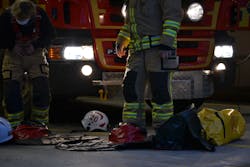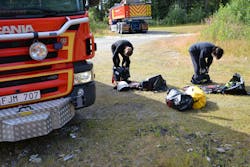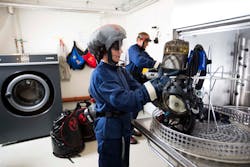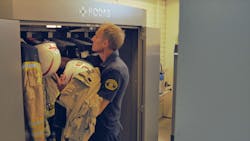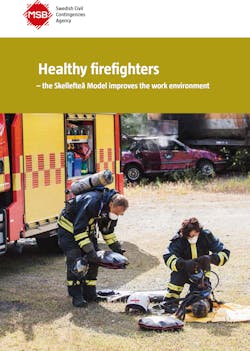Skellefteå Model Develops Healthy Firefighters
It is difficult today to find a firefighter who does not have colleagues affected by suspected occupational illnesses. Healthy Firefighters started as a cooperative project* in 2006 after we lost too many of our close colleagues to suspected occupational diseases. The need for change was apparent: Firefighters need to be protected against work-related diseases.
In the early 2000s, there was already clear evidence that firefighters, through their occupation, have a higher rate of severe diseases. Most diseases could possibly be avoided by reducing unnecessary and involuntary exposure to foreign substances and particles. Because firefighters’ risk of disease was not restricted locally or nationally, a generic global model was needed. Through knowledge, routines and the right equipment, it is possible to methodically minimize the risks of exposure without complicating or impairing the work of firefighters.
The Skellefteå Model was developed as a standard that exemplifies and describes how firefighters can avoid hidden dangers in their working day with the use of simple routines and rational flows. The goal of the model is for the firefighters to avoid serious illness resulting from long-term and repeated contact with foreign substances. The model is based on the thesis “from one alarm to the next,” which also summarizes the cyclic activities of firefighters called into duty. Embracing this way of thinking is comparable with always aiming for perfection, using the latest knowledge and technology for us to carry out our work as efficiently and safely as possible.
The Skellefteå Model is now a tried-and-tested approach for creating a good and sustainable work environment with simple procedures. The model deals with normal operations found in all fire departments and emergency services in varying degrees and frequency. Naturally, local opportunities and conditions must be taken into account for the department in question.
Emergency services that introduce the entire Skellefteå Model protocol will quickly see tangible results in the work environment. It is only after implementing the new procedures and seeing the results that participants realize exactly what the situation was like before they instituted the Skellefteå Model.
Education first
Most firefighters do not suffer from a serious occupational illness. However, for those affected, it often takes a very long time before the illness develops. This latency period is one of the biggest reasons for the situation not changing appreciably, particularly as many firefighters retire before they fall ill. Therefore, there is not always a direct correlation between the illness and the professional life. In order to change this situation for the better, knowledge and insight must be quickly disseminated.
The best way to begin to bring about change is to inform and educate firefighters about the hidden risks of contamination that exist in their work—and what can be done about this risk. Firefighters’ perception of their own work environment does not always match reality. This is partially due to professional culture, attitudes and the fact that these threats or dangers have relatively unclear and vague forms.
To create motivation for change, it is necessary to provide information about the risks that exist and the harmful effects of poor or non-existent routines. When firefighters gain knowledge and insight into their own situation, it becomes apparent what changes and improvements are necessary. This will in turn make them easier to implement. It is crucial to the results that as many individuals as possible have knowledge about how firefighters are exposed to harmful substances. All personnel in all categories on all levels of the organization must be informed. In order to facilitate changes to ingrained routines and behaviors, everyone must help one another.
Established routines
Firefighters may feel that they rarely work on significant fires that would expose them to large amounts of foreign substances. However, it is easy to forget that they are most likely exposed to a larger amount of contaminants from the total number of small fires they are extinguishing than from fewer numbers of large fires. Firefighters may be exposed to hazardous substances during their own calls and training exercises, but also when they come in contact with the contaminated equipment of their colleagues, if it has not been properly handled. It may be tempting to skip the decontamination routines under poor conditions. If there are no established procedures in place, those affected may come to accept a hazardous environment under the premise “it was just this one time.”
Further, consider this: One of a firefighter’s regular duties is to decontaminate vehicles, materials and protective clothing that have been in contact with foreign substances in connection with fires, accidents and exercises. It is common for gear to be cleaned and handled by a firefighter who does not know how it was used or how it was contaminated. Because firefighters have irregular working hours, varied workloads and a large number of shifting operations, jobs can sometimes be interrupted and then completed by a different person. Frequently, in the event of interruptions, such as an alarm, shift change or abnormally long and large-scale operations that require relief or extra personnel, a firefighter may have to take over a colleague’s tasks. This means that the firefighters lose a sense of context, and thereby control, over what the gear and equipment have been exposed to. Unfortunately, this can result in all particles and pollutants being handled routinely. Because the firefighters are unable to verify which substances they risk encountering, they must use the precautionary principle. All unknown particles and remains from dense combustion gas should be considered harmful, as there is no evidence to the contrary.
Concise flows and routines are required in order to distinguish contaminated clothes, gear and vehicles from what is clean. However, these flows and routines should neither delay nor complicate everyday work. Experience clearly shows that anything that consumes time and energy, or includes a greater number of operations, tends to be avoided. Without a frame of reference, it is difficult to compare a thoroughly decontaminated work environment with one that is imperceptibly contaminated. Controlling the work environment may not necessarily lead to a decrease in, or elimination of, serious illnesses. As future firefighters become healthier, it may be difficult to prove it is a direct result of improved routines and flow.
New routines that lead to a higher frequency of cleaning and decontaminating materials will take more time and resources if done improperly. Therefore, it is important to keep the new elements simple, so they remain a priority. One of the most common misunderstandings is that health awareness must be at the expense of aggressive firefighting. This perception could not be more wrong. As a firefighter, you do not have to choose between doing effective rescue efforts and avoiding occupational disease. On the contrary, a good routine for reduced exposure will provide all the conditions for even more efficient and rapid efforts. Organizations that implement the Skellefteå Model in a thought-out, well-prepared manner, and with the right resources, will find that everyday operations will be less complicated than before and certainly more efficient.
It is not enough simply to change behaviors and routines. There must be proper equipment to ensure the right conditions for a sound and health-conscious work environment. Recently the development of specialized encapsulation bags, gross decontamination machines, drying cabinets, wet wipes, etc., has been heading in the right direction. These items were not on the market a few years ago, but if there is a demand, there will be tools.
Buy-in and balance
Sound health is a fundamental condition for a good life and is therefore a precious gift. It is also an area that affects everyone. When the everyday behavior and routines of a given group change, regardless of which areas are concerned, there are individuals who deny or belittle new findings, changes or reforms. Fortunately, even these individuals become interested and are influenced by clear decisions concerning the vulnerability of their own health.
This is one of the reasons why it is so important that a well-composed, clear message about working with health issues is firmly established and communicated to everyone in the concerned organization. As the process considers everyone’s health, even those opposed to change tend to stop hindering the development. It is then easier for those driving the process to garner attention for the necessary adaptations and improvements.
We are often asked how we cope with resistance and barriers in the change process. It is important to point out that doubts do not fundamentally have to be negative. All organizations benefit from the balance between new ideas and sound management. The fact that we work in such well-functioning organizations, as fire departments most often are, is largely due to having both colleagues who want to change and develop, and colleagues who value well-proven, pragmatic methods that work. Both parts are needed to make our work function efficiently.
Further, it is important not to confuse lack of willingness to change with the lack of empathy or understanding. Even our colleagues who do not want to fundamentally change their way of working often take the issues of occupational health seriously. If the directive for changing the working environment does not come with well-founded explanations, it may take time to make the change.
When introducing new elements that alter habitual behavior, the person who is to carry out the new element must be told why. Otherwise, there is a risk of interrupting the decontamination process, which would eliminate the use of the new work method. The emergency services constitute a utilitarian organization, and it is preferable if the benefits of a certain change can be shown in advance. Change will be promoted by the firefighters themselves if credibility and support for the method is established throughout the organization.
It is obvious that the work with firefighters’ disease problems requires individual responsibility. This means that an individual who deviates from the routine will risk exposing themselves and their colleagues to what everyone is trying to avoid. Hence, the Skellefteå Model is based on a team approach—“one for all, and all for one.” Those who show respect for themselves quickly win respect from others.
Start the change process
There are a thousand excuses to delay or complicate the introduction of reducing exposure in a firefighting organization. One apprehension is that it takes a lot of work to get started. Fortunately, the actual solution is very simple, and in many cases, the concerns have proven to be unfounded. A risk during the introduction is that focus is placed on the problems rather than the solutions. But it’s all about getting started. After that, the fine-tuning and the local adaptations will follow naturally. Each day that passes without addressing firefighters’ health issues is a day wasted.
*The collaboration was established among The Swedish Municipal Workers’ Union (Kommunal), The Confederation of Swedish Firefighters (Brandmännens Riksförbund), the Swedish Association of Local Authorities and Regions (Sveriges Kommuner och Landsting) and Sobona (previously Pacta).
Sidebar: Skellefteå Model Steps
With knowledge, education and insight serving as its foundation, the Skellefteå Model employs several tactics related to the following topics to help keep firefighters healthy:
· Transportation of contaminated clothing and equipment
· Routines at the fireground
· Storage of contaminated clothing and equipment
· Skin protection on scene
· Decontamination of body, clothing and equipment
Learn how to implement the Model at healthyfirefighters.com, and watch an informative video that details the steps. Additionally, download a free educational PDF about the Skellefteå Model.
More from the Cancer Awareness & Prevention supplement:
Download the full Cancer Awareness & Prevention supplement here.
David Hultman
David Hultman is a senior officer fire protection engineer who studied at Luleå University in Sweden. Since his post-graduate studies, Hultman has worked within the fire and rescue service, and today he is district/unit chief in Strängnäs, Sweden. He is also a certified fire investigator and has a position on the Board of the Swedish Fire Protection Association and on the Swedish Fire and Risk Engineers Board.
Stefan Magnusson
Stefan Magnusson is a professional firefighter and the health and safety representative for the Skellefteå Fire & Rescue Service in Sweden. In 2006, Magnusson co-founded the Healthy Firefighters project, and he is the creator of the Skellefteå Model. Since 2007, he has delivered hundreds of lectures on the Healthy Firefighters project and the Skellefteå Model. Magnusson has a position on the board of Firefighters Cancer Foundation.
